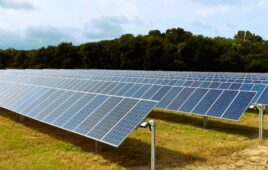Update 11/10: The Ohio House Public Utilities Committee heard testimony from an array of organizations supporting legislation that would enable a community solar program in the state, including the Coalition for Community Solar Access.
On October 12, Ohio Reps. Brian Baldridge and Laura Lanese, both Republicans, introduced House Bill 450 to permit community solar in the territories of the electric distribution utilities (EDUs). To date, community solar has not been available in EDU territories due to the inability for customers to participate in aggregate or virtual net metering.
The legislation authorizes the Public Utilities Commission of Ohio (PUCO) to certify up to 2,000 MW of community solar projects. PUCO may also certify an additional 1,000 MW of community solar project constructed exclusively on “distressed sites,” as long as the majority of these projects are located in the Appalachian region.
In part, a “community solar project” must meet the following requirements:
- The facility has at least three subscribers. No subscriber can hold more than a 40% proportional interest in the output of the facility, and at least 60% of the facility capacity must be subscribed by subscriptions of 40 kW or less.
- Community solar projects cannot have a nameplate capacity of more than 10 MW, unless the project is located on a “distressed site.”
- Projects constructed on distressed sites may have a nameplate capacity of up to 45 MW.
- The facility is located on one or more adjacent or contiguous parcels of land and is not located within one mile of solar facilities under the control of the same entity.
- An EDU cannot control a community solar project but its affiliate may control the facility.
A “distressed site” means a site of contiguous parcels where the majority of the acreage is: 1) a brownfield as defined under R.C. 122.65; 2) within an area where an investor may receive a new markets tax credit under section 45D of the Internal Revenue Code; and/or 3) a closed solid waste facility licensed by the environmental protection agency under R.C. 3734.02. In addition to the increased nameplate capacity referenced above, community solar projects located on distressed sites shall be eligible to receive grant money awarded by the Ohio Department of Development from the brownfield remediation program under R.C. 122.6511 for costs associated with construction and remediation.
A subscriber to a community solar project will be eligible for net metering under R.C. 4928.67. However, a subscriber’s share in a community solar project cannot represent more than 120% of their average annual electricity use.
The legislation requires the PUCO to promulgate rules within six months of the legislation’s effective date. The rules must establish a process by which community solar project certification applications are approved or denied within 90 days, unless good cause is shown for not meeting the deadline. The rules must also establish a process to reasonably allow the transfer and portability of subscriptions. The PUCO will also be required to provide an annual report to the General Assembly with information about the number of projects and usage details.
News item from Bricker & Eckler Attorneys at Law






“”The legislation authorizes the Public Utilities Commission of Ohio (PUCO) to certify up to 2,000 MW of community solar projects. PUCO may also certify an additional 1,000 MW of community solar project constructed exclusively on “distressed sites,” as long as the majority of these projects are located in the Appalachian region.””
Don’t want to be a “Debbie downer” 2GW of distributed community solar PV is really great. Lest we forget how behind Ohio really is in accepting renewable energy and the application of Solar PV, Wind and energy storage as a “new normal”. On the road to grid decarbonization and the increased use of BEV over ICE transportation in the years to come, Ohio needs about 350GWh a day generation “just” to cover the domestic population electricity use. When it comes to electrification of the transportation sector one could need up around another 111GWh of electricity generation a day to charge electric vehicles for the next day’s drive. This presents probably a mix of solar PV and wind generation of around 115GWpeak for at least 4 hours every day. That right there is several really (giga) large redox battery complex that needs to be built regionally to insure enough energy for a days needs in the State.